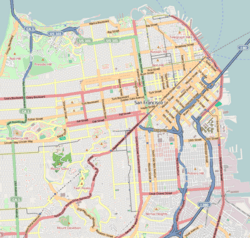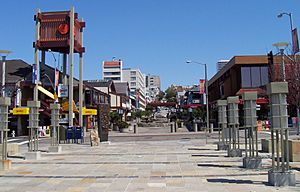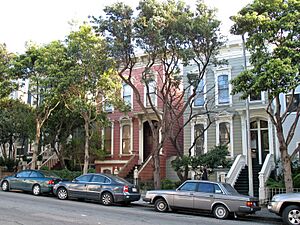Japantown, San Francisco facts for kids
Quick facts for kids
Japantown
日本町
|
|
|---|---|
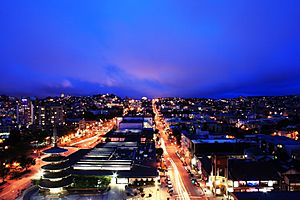
View from Kabuki Hotel facing west. Below is the Japan Center and Peace Pagoda
|
|
| Nickname(s):
Little Osaka,
|
|
| Country | |
| State | |
| City-county | San Francisco |
| Area | |
| • Total | 0.036 sq mi (0.09 km2) |
| • Land | 0.036 sq mi (0.09 km2) |
| Population | |
| • Total | 1,397 |
| • Density | 38,800/sq mi (14,980/km2) |
| Time zone | UTC−8 (Pacific) |
| • Summer (DST) | UTC−7 (PDT) |
| ZIP code |
94115
|
| Area codes | 415/628 |
Japantown (Japanese: 日本町, Hepburn: Nihonmachi), also called Japanese Town, is a neighborhood in the Western Addition area of San Francisco, California. Japantown is about six city blocks big. It is one of the biggest and oldest places in the United States where many people of Japanese heritage live.
Contents
Where is Japantown?
The main street in Japantown is Post Street. It runs between Fillmore Street on the west and Laguna Street on the east. The neighborhood is usually thought to be bordered by Bush or Pine Street to the north. To the south, it is bordered by Geary Boulevard.
The most important spot in Japantown is the Japan Center. It opened in 1968 and has three shopping centers focused on Japanese goods. The Peace Pagoda is also at the Japan Center. It is a five-story concrete tower designed by Japanese architect Yoshiro Taniguchi. The people of Osaka, Japan, gave it to San Francisco.
A Look at Japantown's Past
Japanese immigrants started moving into this area after the big earthquake in San Francisco in 1906. Before 1906, San Francisco had two smaller Japantowns. After the earthquake, the main Japantown grew in the Western Addition.
By World War II, this neighborhood was one of the largest Japanese communities outside of Japan. It looked a lot like the Ginza district in Tokyo.
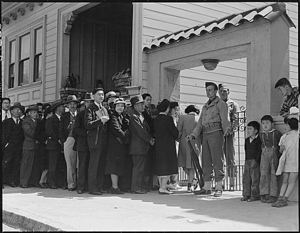
In February 1942, President Franklin D. Roosevelt signed an order. This order forced all people of Japanese background, including Japanese American citizens, to leave the Pacific coast. They were sent to internment camps. By 1943, many parts of Japantown were empty because of this forced move.
Thousands of African Americans then moved into these empty areas. They came from the South to find jobs in factories during the war. This was part of a big move called the Great Migration.
After the war, some Japanese Americans came back. New immigrants from Japan also arrived. The Japanese Government and Japanese companies also invested money here. However, many Japanese Americans did not return to the neighborhood. Instead, they moved to other parts of the city or to the suburbs.
In 1957, San Francisco and Osaka, Japan, became sister cities. This is why Japantown is sometimes called "Little Osaka." Osaka is San Francisco's oldest sister city. To celebrate their 50th anniversary, one block of Buchanan Street in Japantown was renamed Osaka Way in 2007.
What to See and Do
Japantown has many Japanese cuisine restaurants, supermarkets, and shopping malls. You can also find hotels, banks, and other stores. One of the few U.S. branches of the big Kinokuniya bookstore chain is here. Most of these businesses are in the Japan Center shopping mall. This mall was built in the 1960s. There are also some Korean restaurants, a grocery store, a spa, and a beauty shop nearby.
Fun Festivals
San Francisco's Japantown hosts two big festivals each year. The Northern California Cherry Blossom Festival happens over two weekends in April. The Nihonmachi Street Fair is held one weekend in August.
During the first weekend of the Cherry Blossom Festival, a special program takes place. Young women of Japanese or Japanese-American background are chosen to represent their community. On Sunday, they ride on a float in a parade.
Important Buildings
Between 1960 and 1980, the San Francisco Redevelopment Agency bought many old Victorian houses. They moved them to different spots within the Western Addition, including Japantown. Most of these houses were built using local Redwood wood.
- Building at 1840–1842 Eddy Street, 1840–1842 Eddy Street. This house was built in 1875. It is listed as a California Historical Landmark and on the National Register of Historic Places.
- Building at 1813–1813B Sutter Street. Built in 1876, this building was used for homes and shops. It is also a California Historical Landmark and on the National Register of Historic Places.
- Building at 1735–1737 Webster Street, or Vollmer House, 1735–1737 Webster Street. This house was built between 1876 and 1885. It is a California Historical Landmark and on the National Register of Historic Places.
- Bush Street–Cottage Row Historic District, 2101–2125 Bush Street, 1–6 Cottage Row, and 1940–1948 Sutter Street. This area includes 20 historic homes, a walkway, and a small park. It is a San Francisco Designated Landmark and on the National Register of Historic Places.
- Japanese YWCA/Issei Women’s Building, 1830 Sutter Street. Japanese women were not allowed in the main San Francisco YWCA. So, Japanese women called Issei started this building in 1912. It is a San Francisco Designated Landmark.
Images for kids
See also
 In Spanish: Japantown (San Francisco) para niños
In Spanish: Japantown (San Francisco) para niños


